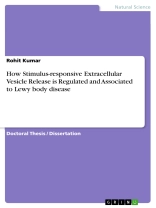Doctoral Thesis / Dissertation from the year 2021 in the subject Biology – Neurobiology, grade: N/A, Technical University of Munich (German Center for Neurodegenerative Diseases (DZNE)), language: English, abstract: Lewy body (LB) disorders, such as dementia with LBs and Parkinson’s disease with dementia (PDD) are characterized by their pathological hallmark, i.e., the gradual appearance of LBs. Therefore, a deep understanding of the molecular and cellular mechanism, favoring the formation of LBs is required.These proteinaceous inclusions are found in different cell types of the nervous system. The key constituent protein-component of such inclusions is the protein alpha-synuclein (α-Syn). α-Syn along with other bio-active material gets secreted as content of extracellular vesicles (EVs). These vesicles not only excrete bioactive material but are also able to transport it to distant sites, and therefore have implications for disease pathology seeding and spreading.Using patch-clamp electrophysiology techniques along with simultaneous real-time molecular imaging, we determined the kinetics of EV-release in hippocampal neurons. We designed a p H-sensitive molecular tag, targeted specifically to membranes of EVs and applied this method to study stimulus-responsive MVB-PM fusion, in order to determine the kinetics, specific stimuli and regulators of such events. In addition, we analyzed the EV-content by performing mass spectrometry (MS) analysis and identifyed LBP-related molecular interactions.
Rohit Kumar
How Stimulus-responsive Extracellular Vesicle Release is Regulated and Associated to Lewy body disease [PDF ebook]
How Stimulus-responsive Extracellular Vesicle Release is Regulated and Associated to Lewy body disease [PDF ebook]
Achetez cet ebook et obtenez-en 1 de plus GRATUITEMENT !
Langue Anglais ● Format PDF ● ISBN 9783346860774 ● Taille du fichier 4.9 MB ● Maison d’édition GRIN Verlag ● Lieu München ● Pays DE ● Publié 2023 ● Édition 1 ● Téléchargeable 24 mois ● Devise EUR ● ID 8928998 ● Protection contre la copie sans












